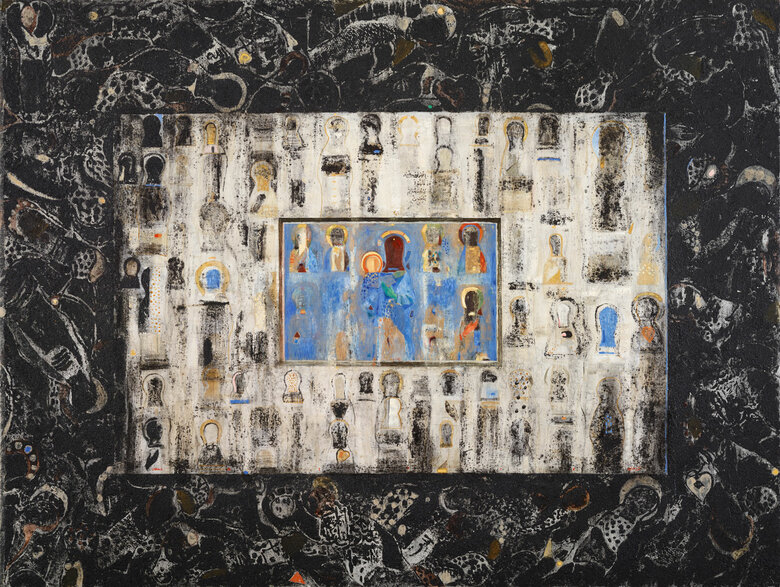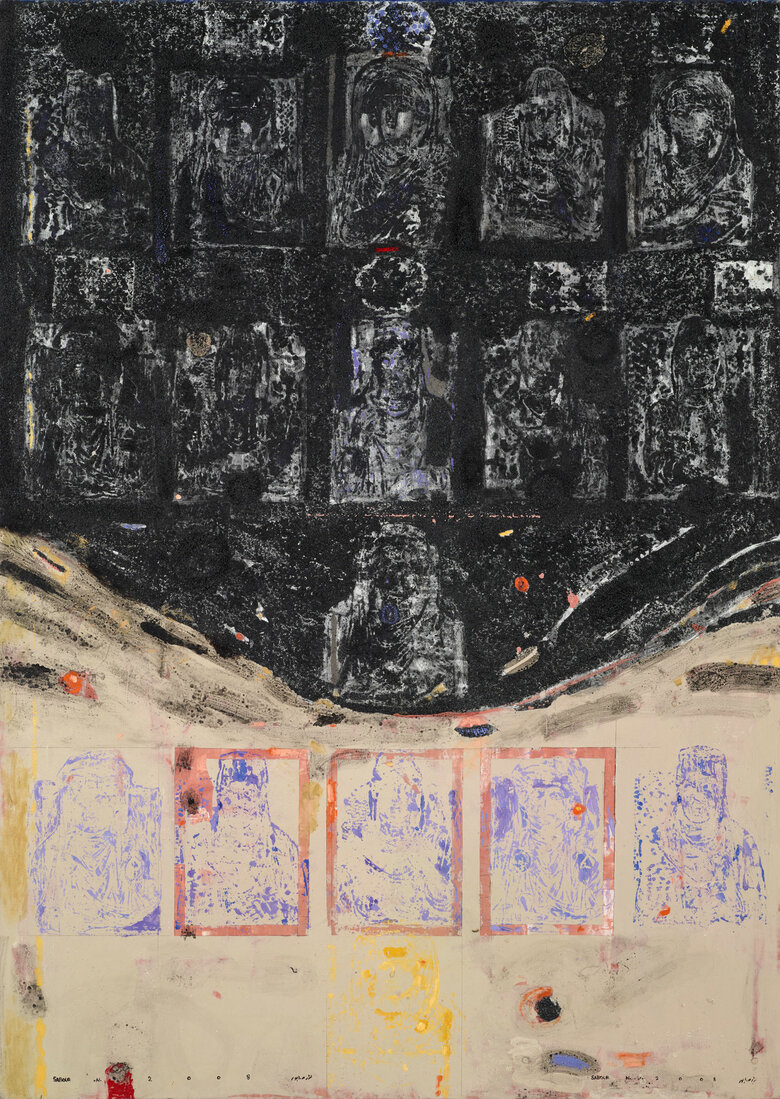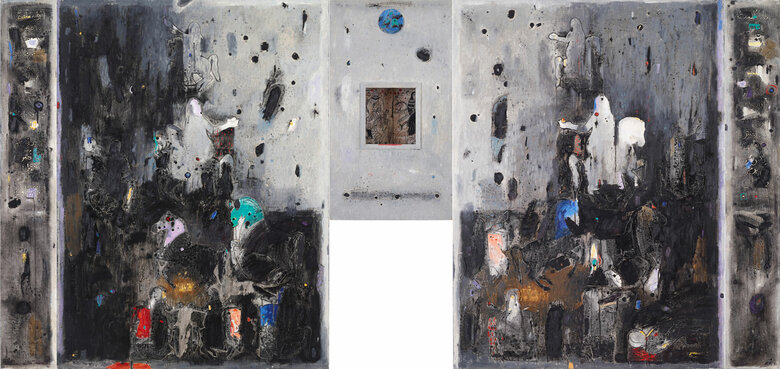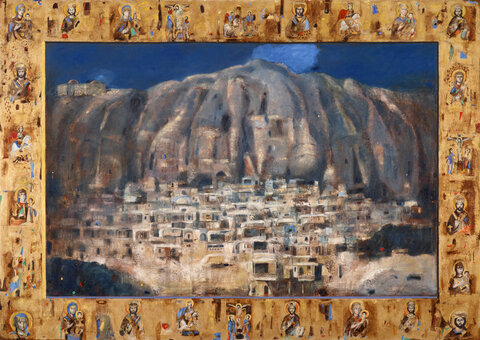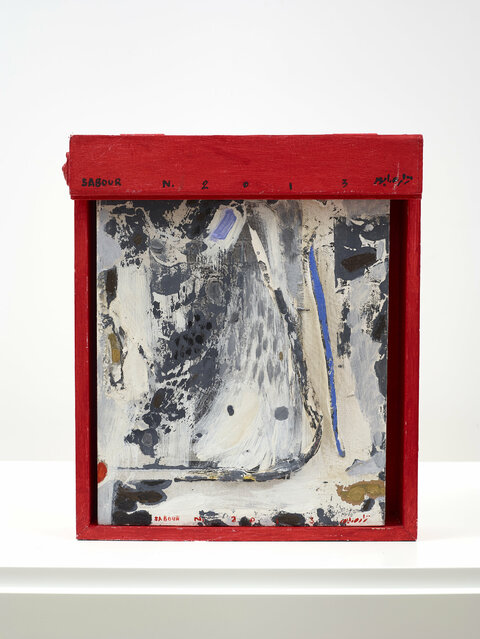Written by Fadia Antar Born in the city of Latakia, Syria, in 1958, Nizar Sabour graduated from the Faculty of Fine Arts, Department of Painting and Drawing, in Damascus, in 1981. He was...
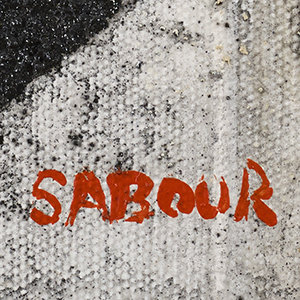

NIZAR SABOUR, Syria (1958)
Bio
Written by Fadia Antar
Born in the city of Latakia, Syria, in 1958, Nizar Sabour graduated from the Faculty of Fine Arts, Department of Painting and Drawing, in Damascus, in 1981. He was taught under prominent modernist Syrian artists such as Fateh Moudares, Nazir Nabaa, Elias Zayat, and Khaled Almaz. The contribution of these masters of Syrian modernism was essential for the young student to build his artistic identity. Indeed, Fateh Moudarres promoted the freedom to think while Nazir Nabaa passed on to him the love of art and sincerity towards his work. These influences shaped Sabour’s personality and position toward art. With such influences, the artist flew to Moscow to pursue his studies. He earned a doctorate of Philosophy in Sciences of Art from the Stroganov Moscow State Academy of Arts and Industry, Russia, in 1990. Back in Syria, Sabour was appointed Professor at the Department of Drawing and Painting at the Faculty of Fine Arts at the University of Damascus from 1991 to the present day. While at his position, he headed several art departments at the University of Damascus and at other institutions. He also holds the position of Professor at the Faculty of Media and Applied Arts at Qalamoun University from 2017 and until today.
Details of Damascus influenced Sabour's first painterly performances when he moved there to pursue his art studies. In essence, the old city alleys, its wooden doors, and architectural façades were departing points for Sabour to create a body of work about Damascus where he represented the city in a suggestive, rather than a realistic approach. To explore this theme the artist was influenced by the Iraqi art exhibitions that took place in Syria at that time. He was mostly drawn by the art of Jewad Selim and Mohamad Muhraddine and the writings of Jabra Ibrahim Jabra, who all advocated for the inspiration from the cultural heritage of the region and the translation of ancient Middle Eastern imagery into modern art forms. In this body of work, Sabour started his lifetime experimentation with local soils, ashes, and olive mill pomace (the black remains of the olive press), rendering the city details in earthy dark colors. By using rough and raw materials, he introduced a tactile experience to his artwork.
Following a similar intention to revive the local cultural heritage, Sabour was infatuated with the Epic of Gilgamesh. He discovered it through the chants of a local artist, Abed Azrié, and immersed himself into the epic’s plots and schemes, listening to the performing voice and the simple acoustics of a solo musical instrument. The songs of Azrié reflected the oriental minimalism appreciated by Sabour, which led him to study the Assyrian art, the origin of the story, and absorb its tendencies to formal abstraction and lack of literal representation. The outcome was a series of paintings (his graduation project in the early 80s), that recreated music and written texts into a pictorial language without the intention to illustrate the scenes or events; instead, he revealed the humanity in the hero figure, using colors, signs, and symbols. In his depiction of the epic characters, the artist aimed to convey their internal conflicts and spirituality more than to represent accurately their details. Better than a precise portrayal of life, in the series of Gilgamesh, Sabour showed a positive link to life. His red hues, shimmering glitters, and the blue of the skies and seas of Gilgamesh remained the artist’s references to date.
At the end of 1985, Sabour arrived in Moscow with a sharp artistic personality at its early development, to witness its influential school of Socialist Realism (the predominant form of approved art in former Soviet Union). The powerful subjects and the high level of drawing and painting skills he perceived, overwhelmed the young artist. For years, he was trained to create realistic portraits and landscapes, at the same time, he had the opportunity to attend several modernist's exhibitions that took place in Moscow in the 90s, like the retrospectives of Marc Chagall, Francis Bacon, Jean Arp, Kazimir Malevich, and many others. The Moscow experience was a formative one: while giving him the accurate skills it guided him to question the Socialist Realism and distance himself of any "isms" idolatry, validating the self-expression of the artist and his connection to his own culture and uniqueness.
After the Moscow experience and as a continuation to his early Damascus project, the artist visited regularly the subject matter of the Oriental Cities, from 1973 until 2003. Influenced by several Middle Eastern cities, his city took the shape of a generalized eastern one, with no definite geographic references, but only anchored in history, personal and collective memory. To extract his city from the nostalgia and place it in a timeless zone, Sabour did not practice any illusion of reality; he implemented a gradual perspective starting from the bottom up, creating a space in between flatness and controlled depth. The flatness in his works takes the eyes of the viewer to a unified surface, the one dimension, in the way of religious manuscripts and icons: Sabour sanctified his city.
Always interacting with the surrounding social and political events, Sabour addressed the Palestinian revolution and the disaster of a train burning in Egypt in his series Life in ashes (2001-2003). His media was a means to convey the harshness of the human condition: he used ashes and black olive mill pomace and performed with the roughness of the materials to depict simplified and congregated figures, people who seem to have lost their forms and aspects through tough experiences. Also, the United States’ invasion of Iraq was his motivation to produce the series Antar of our times (2003-2005), where he represented a comparison between the hero figure of yesterday, Antar, with men currently in power. Away from any heroic attributives, men of today represent the fallen hero figure. Sandouk al Forjah- Antar (Memory and present), 2003, part of Dalloul Art Foundation's collection is an example of this series.
Influenced by the artist's Eastern and Christian environment, Sabour's works are a fusion between the styles of the miniatures and of the icons. The artist acquired his first visual lessons through the icons found in the homes and churches of the old city of Latakia. The icon's structures dominated his entire work, and he dedicated to the subject a series called Contemporary Icon, produced from the year 1988 to 2009, and later the series Palmyra Icons, from 2009 to 2010. Here, and in his entire oeuvre, Sabour tried, as in the art of miniatures, to create a continuous visual movement on the surface of his painting by distributing single colored spots of colors: a yellow, red or blue dot that wanders on the painting, capturing the attention of the viewer and reducing any perception of depth. Sabour used for his Icon, his thick media of dust and soils, on hard wooden boxes, sometimes adding a shelf with a chandelier on its bottom, and opened in those boxes windows which showed the features of the saints. By creating rigid carcasses, borderline between the inner sacred universe of the saints and the outside world, Sabour implies that the work of art is, beyond what is happening on its surface, a manifestation of spirituality.
Amid the beginning of the current unfortunate events happening in Syria, in 2011, Sabour stopped his art production for a while, to restart with a series Epitaphs, which were death announcements for every Syrian sect, stating that conflict is a way to kill everyone. In the absence of basic life utilities (water, electricity) and hard daily conditions, it was impossible to produce large works. Sabour created a series of thirty artist wooden books between 2012 and 2013. Every book was made out of seven wooden pages sometimes pierced with bullets, and where the artist inscribed his poignant statements: "In Damascus there are more mortar shells than sparrows"; "We raise our children so they can flee out of this country." An example of the artist wooden books his work Feelings prior to the American strike, 2013, part of DAF's collection.
From 2014, and after the assault over the district of Qalamoun in Syria with its religious and historical cities, Nizar Sabour created the series Qalamoun. Maaloula (2016-2017) from the Qalamoun series is part of the collection of DAF. It portrays the city of Maaloula, a town northeast of Damascus, built into the rugged mountainside and where the old Aramaic language (the language of Christ) is still spoken to date. This city witnessed its churches and old icons burned by the fighting militias. Sabour used his ashes and olive mill pomace mix, creating a thick, solid, and dark presence to the mountains surrounding the city. The icons and religious figures, which constitute the local cultural heritage, are gathered on the frame to form a protective shield around the city.
Nizar Sabour is a prolific artist who transferred the spiritual details of his homeland into painterly projects, and, at the same time, retracted this spirituality exclusive to the places of worship and made it accessible to the viewers. His art records all the region's sufferings, but is always rendered with hints, rather than direct representations. He continues to the present day to teach and work between Latakia and Damascus, expecting better days for Syria to come: “I live in a state of waiting, waiting for the end, the end of all this madness, so that we can return to life"[1].
[1] Quote by Nizar Sabour at: Kasim, Ali. “نزار صابور فنان سوري يبحث عن الحياة ي الموت: .” صحيفة العرب, February 7, 2020. https://alarab.co.uk/نزار-صابور-فنان-سوري-يبحث-عن-الحياة-في-الموت.
Sources
Kasim, Ali. “نزار صابور فنان سوري يبحث عن الحياة ي الموت: .” صحيفة العرب, February 7, 2020. https://alarab.co.uk/نزار-صابور-فنان-سوري-يبحث-عن-الحياة-في-الموت.
El Cheikh, Zeina. “Nizar Sabour: Places and Memories, War and Love.” Visual History, October 5, 2019. https://visual-history.de/2019/10/05/nizar-sabour/.
Souwayleh, Khalil. “نزار صابور: ‘ست سنوات’ على الفجيعة السورية.” الأخبار, December 22, 2016. https://al-akhbar.com/Last_Page/234403.
Masri, Monther. “نزار صابور في القلمون وجوه وأيقونات.” alaraby. العربي الجديد, December 29, 2015. https://www.alaraby.co.uk/supplementculture/2015/12/28/نزار-صابور-في-القلمون-وجوه-وأيقونات.
Qāsim al-Sayyid Saʻd. Nizār Ṣābūr, Al-insān - Al-lawḥah. Dimashq: Wizārat al-Thaqāfah, al-Hayʼah al-ʻĀmmah al-Sūrīyah lil-Kitāb, 2015.
This biography was made possible through a two hours interview, by the writer, with Nizar Sabour.
CV
Selected Solo exhibitions
2024
Nizar Sabour: Life Doesn't Die, Udmurt Republican Fine Arts Museum, Izhevsk, Russia
2019
Retrospective exhibition, The National Center for Visual Arts, Damascus, Syria
2017
Damascene Icon, SV Gallery, Beirut, Lebanon
Icons for the Olive Bowl, Kaleemat Galeri, Istanbul, Turkey
Palmyra Icons, The Ryazan State Regional Art Museum, Ryazan, Russia
2016
Six Years, Khan Asaad Pasha, Damascus, Syria
Al Qalamoun, Marc Hachem Gallery, Beirut, Lebanon
2015
Damascene Memories, Orient Gallery, Amman, Jordan
Selections from Nizar Sabour's works, Galerie Holbein 4, Hanover, Germany
2013
Icons of Palmyra, Marc Hachem Gallery, Beirut, Lebanon
2010
Icons of Palmyra, National Museum, Damascus, Syria
Icons of Palmyra, Europe Gallery, Paris, France
Walls of Happiness, Gallery “FA”, Kuwait
2009
Palmyra's Walls, Tjalliat Gallery, Damascus, Syria
News from Syria, Holbein 4 Gallery, Hanover, Germany
2008
Happiness as Possible, Museum of Modern Art, Latakia, Syria
Retrospective from 1973 to 2008, Discover Syria Virtual Gallery, Syria
Visions gallery, Amman, Jordan
2007
Happiness as Possible, Art House Gallery, Damascus, Syria
Antara Of Our Times, Kalimat Gallery Aleppo, Syria
2005
Antara Of Our Times, Dar Al Fan Art Gallery - Khan Asaad Pasha, Damascus, Syria
Life in Ashes, Bilad Al Sham Gallery, Aleppo, Syria
2004
Ahmad Al Adwani Gallery, Kuwait
2003
About Damascus, Fatih Al-Mudarris Gallery, Damascus, Syria
Aida Sharfan gallery, and French Cultural Center, Beirut, Lebanon
2002
Life in Ashes, Atassi Gallery, Damascus, Syria
2001
About Love, Imar Gallery, Latakia, Syria
About Love, Gallery (Dar Al-Mashreq), Amman, Jordan
Retrospective, Exhibition Palace, Lyon, France
2000
Soul Gates, Atassi Gallery, Damascus, Syria
1999
Bilad Al-Sham Gallery, Aleppo, Syria
1998
A Fallen Body the Spirit repels, Rainbow Hall and Atassi Gallery, Damascus, Syria
Cairo Atelier, Cairo, Egypt
1997
Al Sayed Hall, Damascus, Syria
Imar Hall, Lattakia, Syria
Al Khanji Gallery, Aleppo, Syria
Arts Center, Bahrain
1995
Atassi Gallery, Damascus, Syria
1994
Ashtar Gallery, Damascus, Syria
1993
Damascus Gallery, Damascus, Syria
Maram, Beirut, Lebanon
1992
Bilad Al-Sham Gallery, Aleppo, Syria
1991
Al-Sayed Hall, Damascus, Syria
Free Studio, Kuwait
1990
Central Artist House, Moscow, Russia
Imar Gallery , Latakia, Syria
1982
Cultural Center, Latakia, Syria
1976
Fine Arts Center, Latakia, Syria
Selected Group Exhibitions
2024
Expression Unbound. Contemporary Art From The Middle East, Janet Rady Fine Art, London, UK
2021
Cities Under Quarantine - The Mailbox Project, Villa Romana, Florence, Italy
2019
Contemporary Syrian Art, Bremen, Germany
Sketch Exhibition, Mustafa Ali Gallery, Damascus, Syria
Contemporary Syrian Art, in collaboration with Second Presbyterian Church, New York City and Khawam Gallery, NY, USA
Emerging Art From War-Torn Syria: War & Hope, ArtSeve in collaboration with Khawam Gallery, Florida, USA
2017
Al Funun Gallery, Kuwait
2015
Long Live Syria, Boushehri Art Gallery, Kuwait city, Kuwait
2014
Scattered, Gathered - Issam Kourbaj & Nizar Sabour, Contemporary Art Platform (CAP), Kuwait city, Kuwait
2013
Tajreed - A Selection Of Abstract Art From 1908 – 1960, Contemporary Art Platform (CAP), Kuwait city, Kuwait
2010
Al Bareh Art Gallery, Manama, Bahrain
2009
Paris-Damascus-Regards croisés, National Museum, Damascus, Syria
Cuadro Art Gallery, Dubai, UAE
2008
Teachers exhibition, Palmyra, Syria
Kamel Gallery, Damascus, Syria
Commemoration of the Syrian Fine Art – Memory II, Dummar Museum for arts, Damascus, Syria
Cuadro Art Gallery, Dubai, UAE
Collective exhibition, Fort Hamilton Gallery, New York, USA
Paris-Damascus-Regards croisés, Institut Du Monde Arabe, Paris, France
For you and me, Holbein 4 Gallery, Hanover, Germany
2007
Artists in Jableh Archeological scene, Jableh, Syria
Syrian Contemporary artists, Athens, Greece
2006
The Mediterranean Biennale, Tunisia
Opening exhibition, Hewar Art Gallery, Riyadh, Saudi Arabia
Trends, Beit Jabri, Damascus, Syria
Fourth Mediterranean Biennale, Tunisia
Fourth Tehran Biennale of Contemporary Art, Iran
Shams Days, Istanbul, Turkey
2005
Inaugural Exhibition of the Jordan National Gallery Complex, Under the patronage of Their Majesties King Abdullah and Queen Rania Al – Abdullah, Jordan National Gallery of Fine Arts, Amman, Jordan
Syrian Cultural week, Abu Dhabi, UAE
Artist 2005, Istanbul, Turkey
2004
International Arts Symposium, Emaar, Dubai, UAE
Contemporary Arab Art Frankfurt, Germany
2002
From the Ocean to the Gulf and Beyond: Arab Contemporary Art, on the occasion of: "Amman the Arab Cultural Capital 2002", Jordan National Gallery of Fine Arts, Amman, Jordan
2001
Women and War, Red Cross headquarters, Damascus, Syria
Four Contemporary Syrian Experiments, Green Art Gallery, Dubai, UAE
Syrian Contemporary Art, Institut du Monde Arabe, Paris, France
Women and War, Red Cross headquarters, Geneva, Switzerland
2000
2000 Assembly, Monte Rosa, Damascus, Syria
Humanities, National Museum, Damascus, Syria
Chairs - Chairs- Damascus, Aleppo and Lattakia, Syria
1999
Beit El Sibaie Artists, Ashtar Gallery, Damascus, Syria
Even War Has limits, Red Cross Headquarters, Damascus, Syria
Even War Has limits, Red Cross Headquarters, Amman, Jordan
Syrian Atelier, UNESCO Palace, Beirut, Lebanon
Women and War, Red Cross headquarters, Amman, Jordan
Fourth Sharjah Biennale, Sharjah, UAE
1998
Beit Sibai Artists, Alfayrouz Gallery, Manama, Bahrein
1997
Third Sharjah Biennale, Sharjah, UAE
1996
Sixth Cairo Biennale, Cairo, Egypt
1995
First Almahabba Biennale, Latakia, Syria
Second Sharjah Biennale, Sharjah, UAE
1994
Five Syrian Artists, Gallery of Cairo, Cairo, Egypt
1992
Five Artists from Syria, Wafa Gallery, Damascus, Syria
Syrian Art Today, Oscar Gallery, Washington DC, USA
1989
Youth of Socialist Countries, Manning Gallery, Moscow, Russia
1988
Young Russians, Manning Gallery, Moscow, Russia
1975
Annual Exhibition of Syrian Artists, Damascus, Syria
Positions
2017
to date
Professor at the Faculty of Media and Applied Arts, Qalamoun University, Syria
2017-
2018
Dean of the Faculty of Media and Applied Arts, Al Qalamoun Private University, Deir Atiyah, Syria
2011-
2013
Dean of the College of human sciences and Arts, and Head of the Graphic Design Department, the International Private University of Science and Technology (IUST), Damascus, Syria
2005-
2008
Head of the Department of Drawing and Painting at the Faculty of Fine Arts, University of Damascus, Syria
Awards and Honors
2019
Visual artist of the year award, The Syrian Ministry of Culture, Syria
2006
Prize for the Fourth Tehran Biennale of Contemporary Art, Iran
2004
First Prize of Painting, International Art Symposium, Dubai, UAE
1995
First Prize of Painting, First Almahabba Biennale, Latakia, Syria
Certificate of Recognition, Second Sharjah Biennale, Sharjah, UAE
Collections
National Museum and the People's Palace, Syria
Jordan National Gallery of Fine Arts, Amman, Jordan
Museum of Bahrain, Bahrain
Sharjah Museum, Sharjah, UAE
Kinda Foundation, Riyadh, Saudi Arabia
Emaar Foundation, Dubai, UAE
Museum of Eastern Peoples Arts, Moscow, Russia
Oscar Gallery, Washington, USA
Ramzi and Saeda Dalloul Art Foundation, Beirut, Lebanon
Press
المدن - السخام حارس النور في قلمون نزار صابور.pdf
كتب.. نزار صابور.. مبدع اللوحة.pdf
طباعة - نزار صابور في القلمون وجوه وأيقونات.pdf
التشكيلي نزار صابور ... مقاومة الأزمة بالعمل والفن والجمال ...الفنان السوري أقوى من الحرب.pdf
الفنَّان التَّشكيلي السُّوري نزار صابور مشبّع بتقنياتٍ وتوهّجاتٍ لونيّة خلَّاقة – الكومبس.pdf
Art defends life at Nizar Sabour’s art exhibition – Syrian Arab News Agency.pdf
صبري يوسف - الفنَّان التَّشكيلي السُّوري نزار صابور مشبّع بتقنياتٍ وتوهّجاتٍ لونيّة خلَّاقة.pdf
معرض - نزار صابور في غاليري مارك هاشم_ حيث الفجيعة في القلمون هي اللون وهي الحكاية - لور غريّب - النهار.pdf
نزار صابور_ الإنسان ــ اللوحة..وسعد القاسم_ الناقد السلس!.pdf
نزار صابور_ «ست سنوات» على الفجيعة السورية.pdf
“نزار صابور- الإنسان- اللوحة”.. توثيق لذاكرة تشكيلية سورية جريدة البعث.pdf
Tajalliyat - نزار صابور في حوار مع اكتشف سورية.pdf
التشكيلي نزار صابور_ الفنان السوري يقاوم الكارثة بالعمل والفن والجمال – S A N A.pdf
الفنان التشكيلي نزار صابور في خان أسعد باشا يعرض خلاصة دهشته البصرية وجملة مشاعر وقيم نبيلة - اكتشف سورية.pdf
مجلة الكلمة - نزار صابور بروايتي.pdf
الفنان التشكيلي نزار صابور المفكرة الثقافية.pdf
5 فنانين يخلِّدون ذاكرة المدن السورية.pdf
Kunstgalerie in Hannover.pdf
Agenda Culturel.pdf
نزار صابور فنان سوري يبحث عن الحياة في الموت علي قاسم صحيفة العرب.pdf
ماذا نفعل في زمن الحرب؟! … الفنان نزار صابور يعرض ملحمة ست سنوات من المعاناة السورية – الــوطــن.pdf
طباعة - اللوحة والأيقونة.. روحانيات لونية من صابور إلى ماليفيتش.pdf
Six Years of War in Gallery by Nizar Sabour Syrian Culture Gate.pdf
NIZAR SABOUR Artwork
Become a Member
Join us in our endless discovery of modern and contemporary Arab art
Become a Member
Get updates from DAF
Follow Artists
Save your favourite Artworks
Share your perspectives on Artworks
Be part of our community
It's Free!
We value your privacy
TermsCookiesPrivacy Policies
Become a Member
Get updates from DAF
Follow Artists
Save your favourite Artworks
Share your perspectives on Artworks
Be part of our community
It's Free!
We value your privacy
TermsCookiesPrivacy Policies
Become a Member
Get updates from DAF
Follow Artists
Save your favourite Artworks
Share your perspectives on Artworks
Be part of our community
It's Free!
We value your privacy
TermsCookiesPrivacy Policies
Welcome to the Dalloul Art Foundation
Thank you for joining our community
If you have entered your email to become a member of the Dalloul Art Foundation, please click the button below to confirm your email and agree to our Terms, Cookie & Privacy policies.
We value your privacy, see how
Become a Member
Get updates from DAF
Follow Artists
Save your favourite Artworks
Share your perspectives on Artworks
Be part of our community
It's Free!
We value your privacy
TermsCookiesPrivacy Policies

